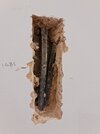
The above is about 8 inches tall.
On reflection they look like they are 2.5mm T&E. I hadn't noticed that there is a 2 gang socket below it.
The depth of the plaster is 45mm.
The left of the image is dot and dab plasterboard. I suspect that (further) to the right will be dot and dab as well. The customer recalls that the builders forgot to fit a socket and extended the ring via the ceiling (rather than ripping up the floor.


